SBM4203: Management Information Systems Report on MIS Applications
VerifiedAdded on 2023/01/10
|8
|1845
|37
Report
AI Summary
This report provides an in-depth analysis of Management Information Systems (MIS) and their crucial role in modern business operations. It explores the practical applications of MIS across various sectors, including manufacturing, medical, and education, highlighting how these systems streamline processes and enhance decision-making. The report further examines the SAP R/3 enterprise resource planning (ERP) system, evaluating its pros and cons and assessing its suitability for diverse business needs. Additionally, it delves into the concept of knowledge management systems and their impact on informed decision-making processes. Finally, the report addresses the topic of employee monitoring, discussing its legal and ethical implications and offering personal reflections on the subject. The report aims to provide a comprehensive overview of MIS, its applications, and its impact on various aspects of business management.

Running head: MANAGEMENT INFORMATION SYSTEM
MANAGEMENT INFORMATION SYSTEM
Name of the Student:
Name of the University:
Author Note:
MANAGEMENT INFORMATION SYSTEM
Name of the Student:
Name of the University:
Author Note:
Paraphrase This Document
Need a fresh take? Get an instant paraphrase of this document with our AI Paraphraser

1MANAGEMENT INFORMATION SYSTEM
Executive summary
The report describes the important uses of the information system. The report also illustrates
the different categories of information systems and also describes the uses of management
information system in medical, educational and manufacturing fields. The report also talks
about the SAP R/3 architecture and its advantages as well as disadvantages. The report also
focusses on the knowledge management system and its use in decision making. Finally the
report ends with concluding notes on employee monitoring and its impact on both employees
and the company. The report also includes a section for the author’s personal remarks and
reflection on the above mentioned topics.
Executive summary
The report describes the important uses of the information system. The report also illustrates
the different categories of information systems and also describes the uses of management
information system in medical, educational and manufacturing fields. The report also talks
about the SAP R/3 architecture and its advantages as well as disadvantages. The report also
focusses on the knowledge management system and its use in decision making. Finally the
report ends with concluding notes on employee monitoring and its impact on both employees
and the company. The report also includes a section for the author’s personal remarks and
reflection on the above mentioned topics.

2MANAGEMENT INFORMATION SYSTEM
Table of Contents
Introduction................................................................................................................................3
Discussion..................................................................................................................................3
Different categories of information systems and the importance of Management
Information Systems..............................................................................................................3
The pros and cons of SAP R/3...............................................................................................4
The knowledge management system and its use in decision making....................................4
Employee monitoring and its impact.....................................................................................4
Personal reflections on employee monitoring........................................................................5
Conclusion..................................................................................................................................5
References..................................................................................................................................6
Table of Contents
Introduction................................................................................................................................3
Discussion..................................................................................................................................3
Different categories of information systems and the importance of Management
Information Systems..............................................................................................................3
The pros and cons of SAP R/3...............................................................................................4
The knowledge management system and its use in decision making....................................4
Employee monitoring and its impact.....................................................................................4
Personal reflections on employee monitoring........................................................................5
Conclusion..................................................................................................................................5
References..................................................................................................................................6
⊘ This is a preview!⊘
Do you want full access?
Subscribe today to unlock all pages.

Trusted by 1+ million students worldwide
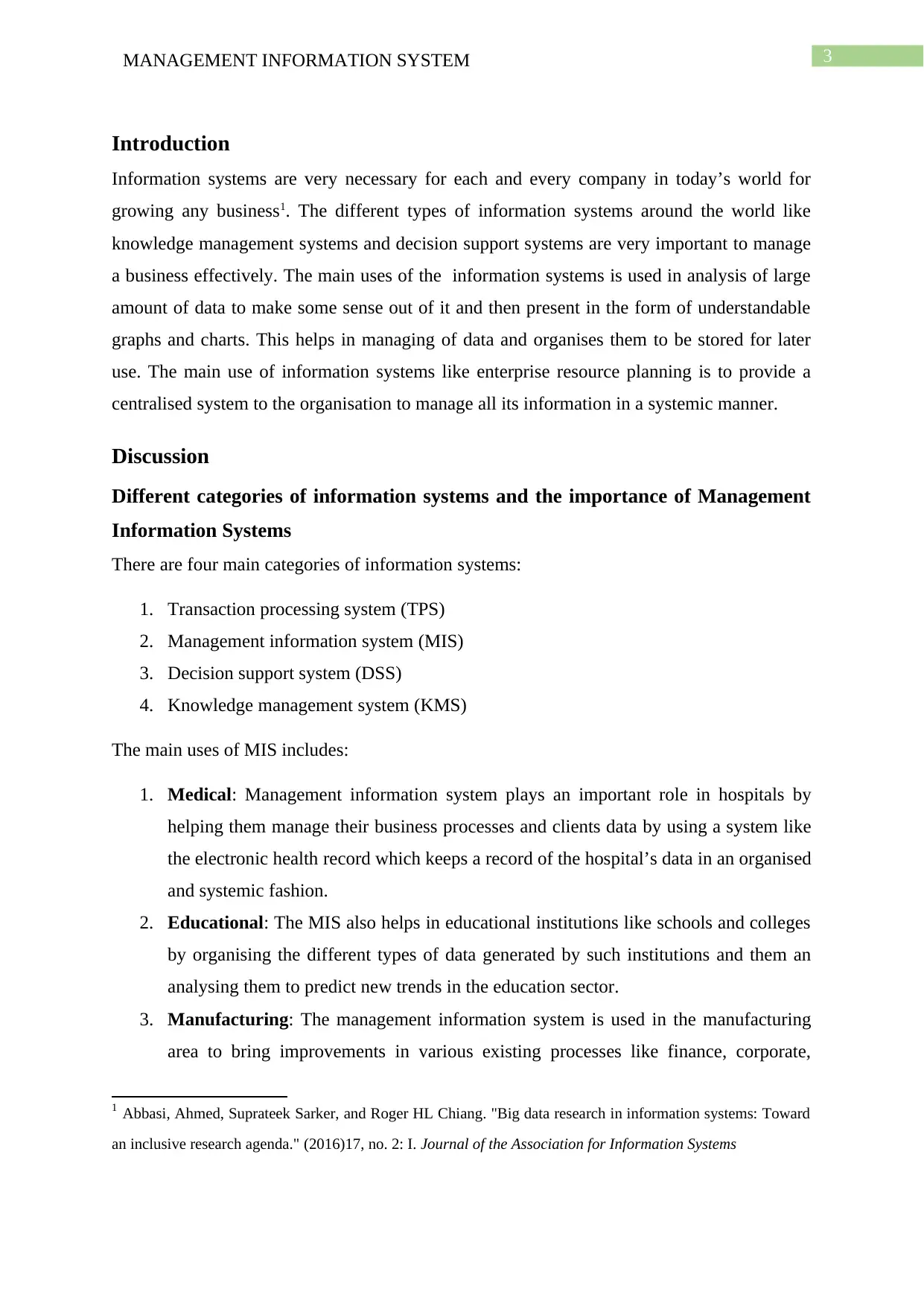
3MANAGEMENT INFORMATION SYSTEM
Introduction
Information systems are very necessary for each and every company in today’s world for
growing any business1. The different types of information systems around the world like
knowledge management systems and decision support systems are very important to manage
a business effectively. The main uses of the information systems is used in analysis of large
amount of data to make some sense out of it and then present in the form of understandable
graphs and charts. This helps in managing of data and organises them to be stored for later
use. The main use of information systems like enterprise resource planning is to provide a
centralised system to the organisation to manage all its information in a systemic manner.
Discussion
Different categories of information systems and the importance of Management
Information Systems
There are four main categories of information systems:
1. Transaction processing system (TPS)
2. Management information system (MIS)
3. Decision support system (DSS)
4. Knowledge management system (KMS)
The main uses of MIS includes:
1. Medical: Management information system plays an important role in hospitals by
helping them manage their business processes and clients data by using a system like
the electronic health record which keeps a record of the hospital’s data in an organised
and systemic fashion.
2. Educational: The MIS also helps in educational institutions like schools and colleges
by organising the different types of data generated by such institutions and them an
analysing them to predict new trends in the education sector.
3. Manufacturing: The management information system is used in the manufacturing
area to bring improvements in various existing processes like finance, corporate,
1 Abbasi, Ahmed, Suprateek Sarker, and Roger HL Chiang. "Big data research in information systems: Toward
an inclusive research agenda." (2016)17, no. 2: I. Journal of the Association for Information Systems
Introduction
Information systems are very necessary for each and every company in today’s world for
growing any business1. The different types of information systems around the world like
knowledge management systems and decision support systems are very important to manage
a business effectively. The main uses of the information systems is used in analysis of large
amount of data to make some sense out of it and then present in the form of understandable
graphs and charts. This helps in managing of data and organises them to be stored for later
use. The main use of information systems like enterprise resource planning is to provide a
centralised system to the organisation to manage all its information in a systemic manner.
Discussion
Different categories of information systems and the importance of Management
Information Systems
There are four main categories of information systems:
1. Transaction processing system (TPS)
2. Management information system (MIS)
3. Decision support system (DSS)
4. Knowledge management system (KMS)
The main uses of MIS includes:
1. Medical: Management information system plays an important role in hospitals by
helping them manage their business processes and clients data by using a system like
the electronic health record which keeps a record of the hospital’s data in an organised
and systemic fashion.
2. Educational: The MIS also helps in educational institutions like schools and colleges
by organising the different types of data generated by such institutions and them an
analysing them to predict new trends in the education sector.
3. Manufacturing: The management information system is used in the manufacturing
area to bring improvements in various existing processes like finance, corporate,
1 Abbasi, Ahmed, Suprateek Sarker, and Roger HL Chiang. "Big data research in information systems: Toward
an inclusive research agenda." (2016)17, no. 2: I. Journal of the Association for Information Systems
Paraphrase This Document
Need a fresh take? Get an instant paraphrase of this document with our AI Paraphraser
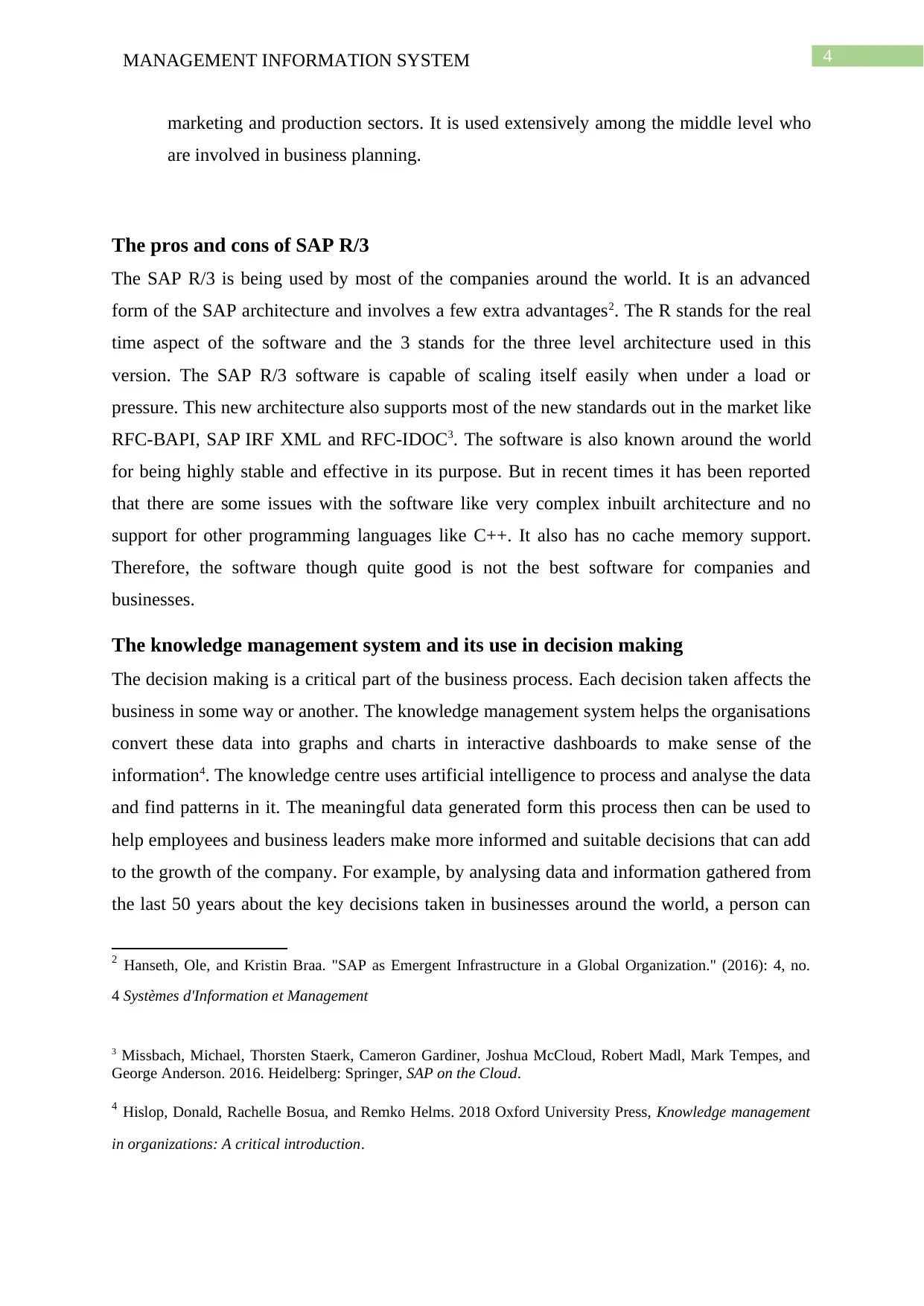
4MANAGEMENT INFORMATION SYSTEM
marketing and production sectors. It is used extensively among the middle level who
are involved in business planning.
The pros and cons of SAP R/3
The SAP R/3 is being used by most of the companies around the world. It is an advanced
form of the SAP architecture and involves a few extra advantages2. The R stands for the real
time aspect of the software and the 3 stands for the three level architecture used in this
version. The SAP R/3 software is capable of scaling itself easily when under a load or
pressure. This new architecture also supports most of the new standards out in the market like
RFC-BAPI, SAP IRF XML and RFC-IDOC3. The software is also known around the world
for being highly stable and effective in its purpose. But in recent times it has been reported
that there are some issues with the software like very complex inbuilt architecture and no
support for other programming languages like C++. It also has no cache memory support.
Therefore, the software though quite good is not the best software for companies and
businesses.
The knowledge management system and its use in decision making
The decision making is a critical part of the business process. Each decision taken affects the
business in some way or another. The knowledge management system helps the organisations
convert these data into graphs and charts in interactive dashboards to make sense of the
information4. The knowledge centre uses artificial intelligence to process and analyse the data
and find patterns in it. The meaningful data generated form this process then can be used to
help employees and business leaders make more informed and suitable decisions that can add
to the growth of the company. For example, by analysing data and information gathered from
the last 50 years about the key decisions taken in businesses around the world, a person can
2 Hanseth, Ole, and Kristin Braa. "SAP as Emergent Infrastructure in a Global Organization." (2016): 4, no.
4 Systèmes d'Information et Management
3 Missbach, Michael, Thorsten Staerk, Cameron Gardiner, Joshua McCloud, Robert Madl, Mark Tempes, and
George Anderson. 2016. Heidelberg: Springer, SAP on the Cloud.
4 Hislop, Donald, Rachelle Bosua, and Remko Helms. 2018 Oxford University Press, Knowledge management
in organizations: A critical introduction.
marketing and production sectors. It is used extensively among the middle level who
are involved in business planning.
The pros and cons of SAP R/3
The SAP R/3 is being used by most of the companies around the world. It is an advanced
form of the SAP architecture and involves a few extra advantages2. The R stands for the real
time aspect of the software and the 3 stands for the three level architecture used in this
version. The SAP R/3 software is capable of scaling itself easily when under a load or
pressure. This new architecture also supports most of the new standards out in the market like
RFC-BAPI, SAP IRF XML and RFC-IDOC3. The software is also known around the world
for being highly stable and effective in its purpose. But in recent times it has been reported
that there are some issues with the software like very complex inbuilt architecture and no
support for other programming languages like C++. It also has no cache memory support.
Therefore, the software though quite good is not the best software for companies and
businesses.
The knowledge management system and its use in decision making
The decision making is a critical part of the business process. Each decision taken affects the
business in some way or another. The knowledge management system helps the organisations
convert these data into graphs and charts in interactive dashboards to make sense of the
information4. The knowledge centre uses artificial intelligence to process and analyse the data
and find patterns in it. The meaningful data generated form this process then can be used to
help employees and business leaders make more informed and suitable decisions that can add
to the growth of the company. For example, by analysing data and information gathered from
the last 50 years about the key decisions taken in businesses around the world, a person can
2 Hanseth, Ole, and Kristin Braa. "SAP as Emergent Infrastructure in a Global Organization." (2016): 4, no.
4 Systèmes d'Information et Management
3 Missbach, Michael, Thorsten Staerk, Cameron Gardiner, Joshua McCloud, Robert Madl, Mark Tempes, and
George Anderson. 2016. Heidelberg: Springer, SAP on the Cloud.
4 Hislop, Donald, Rachelle Bosua, and Remko Helms. 2018 Oxford University Press, Knowledge management
in organizations: A critical introduction.
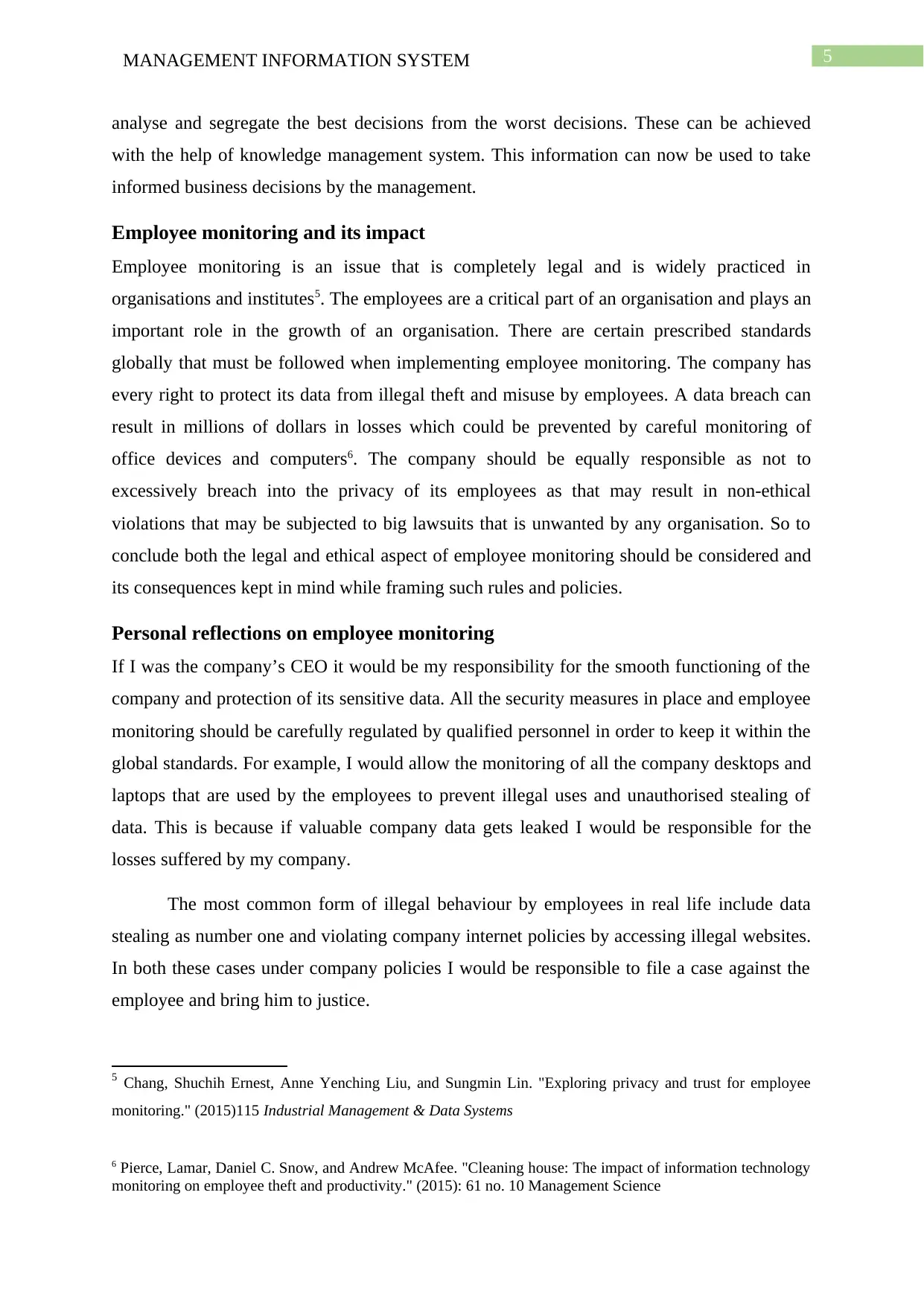
5MANAGEMENT INFORMATION SYSTEM
analyse and segregate the best decisions from the worst decisions. These can be achieved
with the help of knowledge management system. This information can now be used to take
informed business decisions by the management.
Employee monitoring and its impact
Employee monitoring is an issue that is completely legal and is widely practiced in
organisations and institutes5. The employees are a critical part of an organisation and plays an
important role in the growth of an organisation. There are certain prescribed standards
globally that must be followed when implementing employee monitoring. The company has
every right to protect its data from illegal theft and misuse by employees. A data breach can
result in millions of dollars in losses which could be prevented by careful monitoring of
office devices and computers6. The company should be equally responsible as not to
excessively breach into the privacy of its employees as that may result in non-ethical
violations that may be subjected to big lawsuits that is unwanted by any organisation. So to
conclude both the legal and ethical aspect of employee monitoring should be considered and
its consequences kept in mind while framing such rules and policies.
Personal reflections on employee monitoring
If I was the company’s CEO it would be my responsibility for the smooth functioning of the
company and protection of its sensitive data. All the security measures in place and employee
monitoring should be carefully regulated by qualified personnel in order to keep it within the
global standards. For example, I would allow the monitoring of all the company desktops and
laptops that are used by the employees to prevent illegal uses and unauthorised stealing of
data. This is because if valuable company data gets leaked I would be responsible for the
losses suffered by my company.
The most common form of illegal behaviour by employees in real life include data
stealing as number one and violating company internet policies by accessing illegal websites.
In both these cases under company policies I would be responsible to file a case against the
employee and bring him to justice.
5 Chang, Shuchih Ernest, Anne Yenching Liu, and Sungmin Lin. "Exploring privacy and trust for employee
monitoring." (2015)115 Industrial Management & Data Systems
6 Pierce, Lamar, Daniel C. Snow, and Andrew McAfee. "Cleaning house: The impact of information technology
monitoring on employee theft and productivity." (2015): 61 no. 10 Management Science
analyse and segregate the best decisions from the worst decisions. These can be achieved
with the help of knowledge management system. This information can now be used to take
informed business decisions by the management.
Employee monitoring and its impact
Employee monitoring is an issue that is completely legal and is widely practiced in
organisations and institutes5. The employees are a critical part of an organisation and plays an
important role in the growth of an organisation. There are certain prescribed standards
globally that must be followed when implementing employee monitoring. The company has
every right to protect its data from illegal theft and misuse by employees. A data breach can
result in millions of dollars in losses which could be prevented by careful monitoring of
office devices and computers6. The company should be equally responsible as not to
excessively breach into the privacy of its employees as that may result in non-ethical
violations that may be subjected to big lawsuits that is unwanted by any organisation. So to
conclude both the legal and ethical aspect of employee monitoring should be considered and
its consequences kept in mind while framing such rules and policies.
Personal reflections on employee monitoring
If I was the company’s CEO it would be my responsibility for the smooth functioning of the
company and protection of its sensitive data. All the security measures in place and employee
monitoring should be carefully regulated by qualified personnel in order to keep it within the
global standards. For example, I would allow the monitoring of all the company desktops and
laptops that are used by the employees to prevent illegal uses and unauthorised stealing of
data. This is because if valuable company data gets leaked I would be responsible for the
losses suffered by my company.
The most common form of illegal behaviour by employees in real life include data
stealing as number one and violating company internet policies by accessing illegal websites.
In both these cases under company policies I would be responsible to file a case against the
employee and bring him to justice.
5 Chang, Shuchih Ernest, Anne Yenching Liu, and Sungmin Lin. "Exploring privacy and trust for employee
monitoring." (2015)115 Industrial Management & Data Systems
6 Pierce, Lamar, Daniel C. Snow, and Andrew McAfee. "Cleaning house: The impact of information technology
monitoring on employee theft and productivity." (2015): 61 no. 10 Management Science
⊘ This is a preview!⊘
Do you want full access?
Subscribe today to unlock all pages.

Trusted by 1+ million students worldwide
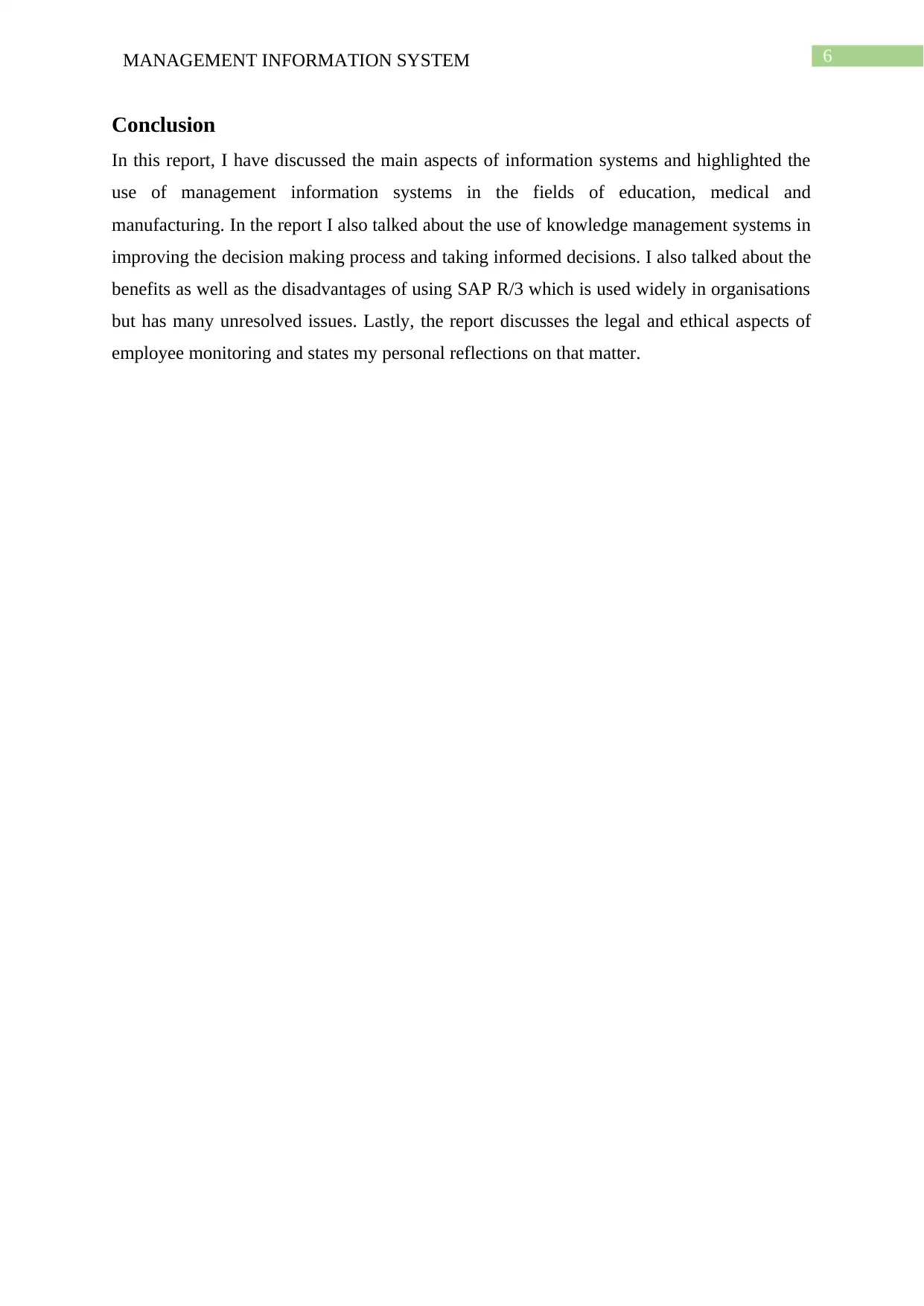
6MANAGEMENT INFORMATION SYSTEM
Conclusion
In this report, I have discussed the main aspects of information systems and highlighted the
use of management information systems in the fields of education, medical and
manufacturing. In the report I also talked about the use of knowledge management systems in
improving the decision making process and taking informed decisions. I also talked about the
benefits as well as the disadvantages of using SAP R/3 which is used widely in organisations
but has many unresolved issues. Lastly, the report discusses the legal and ethical aspects of
employee monitoring and states my personal reflections on that matter.
Conclusion
In this report, I have discussed the main aspects of information systems and highlighted the
use of management information systems in the fields of education, medical and
manufacturing. In the report I also talked about the use of knowledge management systems in
improving the decision making process and taking informed decisions. I also talked about the
benefits as well as the disadvantages of using SAP R/3 which is used widely in organisations
but has many unresolved issues. Lastly, the report discusses the legal and ethical aspects of
employee monitoring and states my personal reflections on that matter.
Paraphrase This Document
Need a fresh take? Get an instant paraphrase of this document with our AI Paraphraser
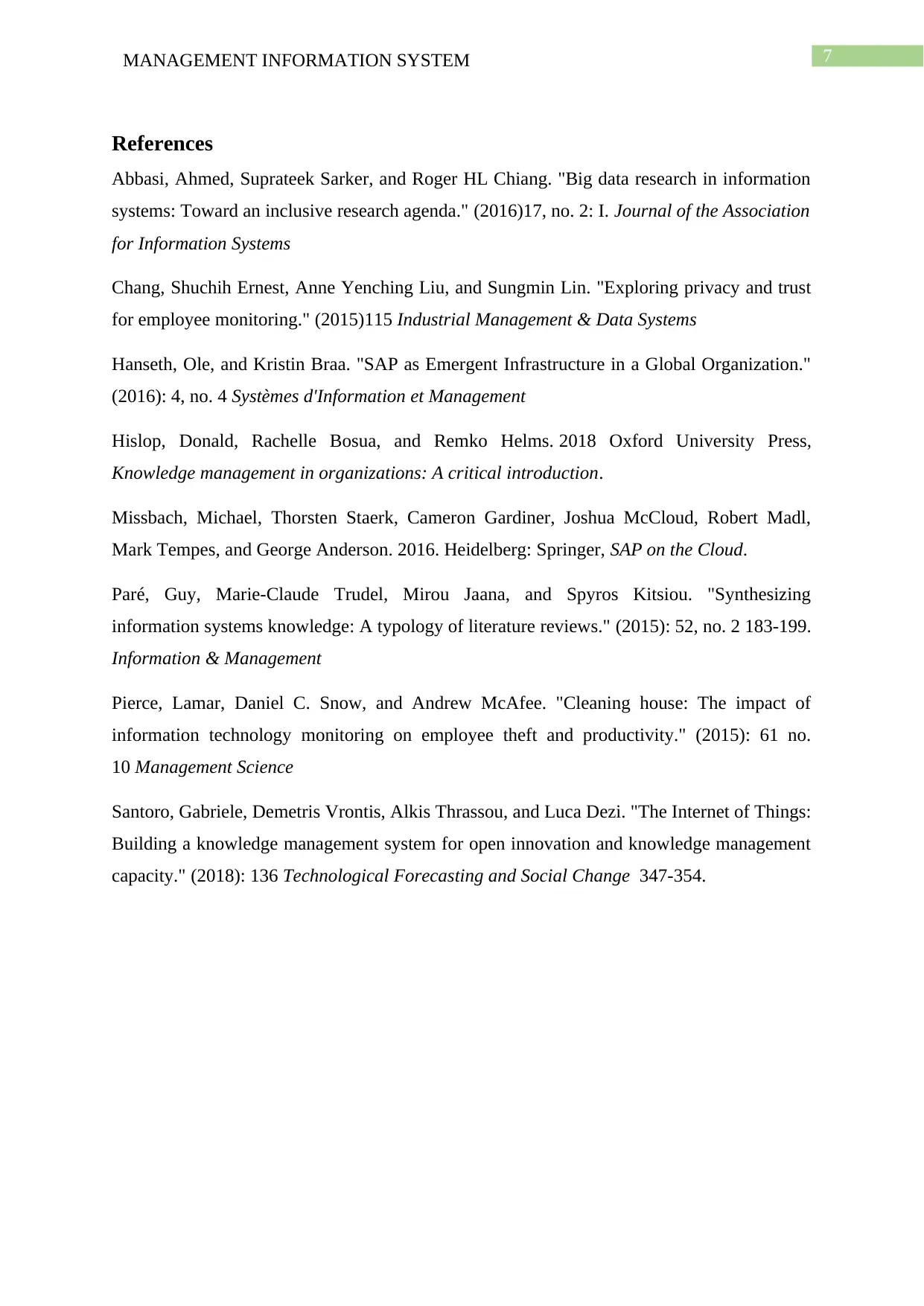
7MANAGEMENT INFORMATION SYSTEM
References
Abbasi, Ahmed, Suprateek Sarker, and Roger HL Chiang. "Big data research in information
systems: Toward an inclusive research agenda." (2016)17, no. 2: I. Journal of the Association
for Information Systems
Chang, Shuchih Ernest, Anne Yenching Liu, and Sungmin Lin. "Exploring privacy and trust
for employee monitoring." (2015)115 Industrial Management & Data Systems
Hanseth, Ole, and Kristin Braa. "SAP as Emergent Infrastructure in a Global Organization."
(2016): 4, no. 4 Systèmes d'Information et Management
Hislop, Donald, Rachelle Bosua, and Remko Helms. 2018 Oxford University Press,
Knowledge management in organizations: A critical introduction.
Missbach, Michael, Thorsten Staerk, Cameron Gardiner, Joshua McCloud, Robert Madl,
Mark Tempes, and George Anderson. 2016. Heidelberg: Springer, SAP on the Cloud.
Paré, Guy, Marie-Claude Trudel, Mirou Jaana, and Spyros Kitsiou. "Synthesizing
information systems knowledge: A typology of literature reviews." (2015): 52, no. 2 183-199.
Information & Management
Pierce, Lamar, Daniel C. Snow, and Andrew McAfee. "Cleaning house: The impact of
information technology monitoring on employee theft and productivity." (2015): 61 no.
10 Management Science
Santoro, Gabriele, Demetris Vrontis, Alkis Thrassou, and Luca Dezi. "The Internet of Things:
Building a knowledge management system for open innovation and knowledge management
capacity." (2018): 136 Technological Forecasting and Social Change 347-354.
References
Abbasi, Ahmed, Suprateek Sarker, and Roger HL Chiang. "Big data research in information
systems: Toward an inclusive research agenda." (2016)17, no. 2: I. Journal of the Association
for Information Systems
Chang, Shuchih Ernest, Anne Yenching Liu, and Sungmin Lin. "Exploring privacy and trust
for employee monitoring." (2015)115 Industrial Management & Data Systems
Hanseth, Ole, and Kristin Braa. "SAP as Emergent Infrastructure in a Global Organization."
(2016): 4, no. 4 Systèmes d'Information et Management
Hislop, Donald, Rachelle Bosua, and Remko Helms. 2018 Oxford University Press,
Knowledge management in organizations: A critical introduction.
Missbach, Michael, Thorsten Staerk, Cameron Gardiner, Joshua McCloud, Robert Madl,
Mark Tempes, and George Anderson. 2016. Heidelberg: Springer, SAP on the Cloud.
Paré, Guy, Marie-Claude Trudel, Mirou Jaana, and Spyros Kitsiou. "Synthesizing
information systems knowledge: A typology of literature reviews." (2015): 52, no. 2 183-199.
Information & Management
Pierce, Lamar, Daniel C. Snow, and Andrew McAfee. "Cleaning house: The impact of
information technology monitoring on employee theft and productivity." (2015): 61 no.
10 Management Science
Santoro, Gabriele, Demetris Vrontis, Alkis Thrassou, and Luca Dezi. "The Internet of Things:
Building a knowledge management system for open innovation and knowledge management
capacity." (2018): 136 Technological Forecasting and Social Change 347-354.
1 out of 8
Related Documents
Your All-in-One AI-Powered Toolkit for Academic Success.
+13062052269
info@desklib.com
Available 24*7 on WhatsApp / Email
![[object Object]](/_next/static/media/star-bottom.7253800d.svg)
Unlock your academic potential
Copyright © 2020–2025 A2Z Services. All Rights Reserved. Developed and managed by ZUCOL.





